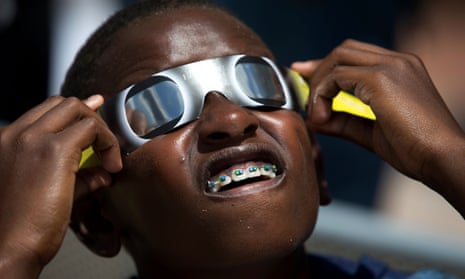Key events
Tory Shepherd
Eclipse chasers from all corners of the globe have descended on a tiny Western Australian town to watch the sun disappear behind the moon.
About 20,000 people will see the total solar eclipse from Exmouth, population (normally) about 2,800 – the gateway town to the Ningaloo Reef and its famous whale sharks.
It will be a rare hybrid eclipse, lasting about three hours. For about a minute, at 11.29am local time on Thursday, the Earth, moon and sun will align perfectly, the moon covering the sun’s disc. There will be a shimmering corona, like a halo around the moon, and the stars and planets will become visible. The temperature will drop. Animals will start acting strangely.
The eclipse will pass directly over Exmouth, where crowds will gather in dedicated viewing areas. As the sky goes dark, others will watch from boats and ships and from parts of Timor-Leste and Indonesia. The rest of Australia will be able to see a partial eclipse.
In Sydney, Australia, it seems unlikely that people will be able to see much of the eclipse at all – the sky is completely covered in cloud. All the more reason to follow along here – we’ll have the latest from eclipse chasers in Exmouth, Western Australia:
What to expect
Shadow snakes. A syzygy. A moment unsettlingly called “the totality”.
For those standing in the shadow of today’s total eclipse, things are going to get weird.
When the sun, moon and Earth line up perfectly it is called a syzygy (and eliminates the earthly need for vowels). Then, acorrding to Mark Cheung, the Deputy Director of Space & Astronomy at Ausralia’s Commonwealth Scientific and Industrial Research Organisation:
The temperature drops, the land and the sea look different, and the stars come out. When the moon completely covers the Sun, the faint solar corona becomes visible.
Just before the corona, an uncanny phenomenon happens: faint shadows slither across the ground. Known as shadow bands or shadow snakes, they’re caused by the refraction of light through the earth’s atmosphere – the same phenomenon that causes stars to twinkle causes these shadows to dance.
You can see them faintly in this video:

Donna Lu
There is still time to rush out and get your solar eclipse glasses. Only approved glasses will absorb the appropriate wavelengths of visible, ultraviolet and infrared light. Here is how to spot a safe pair – they must:
Be bought from reputable vendors to ensure they are not counterfeits.
Display the correct safety certification (ISO 12312-2).
Not be scratched, cracked or show any other signs of damage.
Fit your face properly so no gaps let light in (check they fit over your usual glasses if you need these to see normally).
Be checked by looking at a lamp or lightbulb – only light from the sun should be visible through genuine eclipse glasses. This check doesn’t risk eye damage provided the previous steps have been followed.
Our celestial livestream will start in 30 minutes, so stay tuned. Coming up in the meantime: more on shadow snakes, the totality, coronas, and a sun-eating god of the underworld.
When you can see the eclipse
The total eclipse path will swoop from the Indian Ocean to the Pacific Ocean, mostly over water. For those viewing the total eclipse, it will last a little over a minute.
The partial eclipse, though also brief, will be seen by many more people: here is where and when you can see it in cities in Australia, Vietnam, the Philippines, Indonesia and New Zealand (UTC):
What is a 'hybrid solar eclipse'
Hybrid solar eclipses are rare – there have been only a few in the last 100 years. There is a clue in the name – the way that the sun, moon and Earth will align today means that the eclipse is a combination of two kinds – annular or total, depending on where you are in relation to the moon.
Tanya Hill, the senior curator of astronomy at Museums Victoria explained it like this to my colleague Donna Lu:
“It begins over the Indian Ocean as an annular eclipse, where the moon is slightly too small to completely block the sun and a ring of sunlight shines out from around the dark moon,” she said.
“By the time the moon’s shadow reaches land, it will become a total eclipse – the moon now appears large enough to completely block the sun.”
Where and when to watch the eclipse in Australia
In Australia, only lucky viewers in the state of Western Australia will be able to experience the total eclipse. People in other parts of the country will be outside the area totally covered by the moon’s inner shadow. In other states, the event will be a partial eclipse, with the sun only being obscured to varying extents.
Here is a breakdown of the eclipse times in Australian cities:
Here is our full explainer on when, where and how to safely watch the eclipse in Australia:
Opening summary
Today is the day: the Earth, moon and sun will line up perfectly, causing a rare type of total solar eclipse called a hybrid solar eclipse. It is a phenomenon that occurs just a handful of times every 100 years.
People in parts of Australia, Timor-Leste and Indonesia will have the best view of it: for a few moments it will, if the sky is clear, totally change their surroundings.
But it will be visible in some form across Australia and Indonesia and in parts of New Zealand, Vietnam, the Philippines and Papua New Guinea.
My name is Helen Sullivan and I’ll be bringing you the latest. Before we begin: the same rules apply today as on any other day – don’t stare straight at the sun unless you are looking through a safe material. The best is eclipse glasses (ISO number 12312-2).
You can also watch through a homemade pinhole camera, a colander or a welding mask, if you happen to have any of these things handy.

Follow along for a list of viewing times, reactions from eclipse watchers, and the weirdest things that we can expect, including crescent moon-shaped disco ball-like lights and, more ominously, “shadow snakes”.
And please do send me your pictures, comments and questions on Twitter @helenrsullivan or via email: helen.sullivan@theguardian.com.

 1 year ago
216
1 year ago
216










 English (US)
English (US)